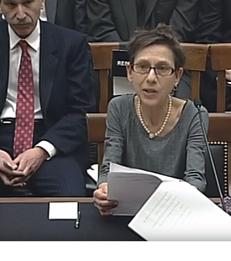Research Highlights
Professor Jeanne Calderon Testifies Before Congress, Citing Research with Gary Friedland on the Immigrant Investor EB-5 Program
—


If Congress seeks to limit the project locations that qualify as a TEA, then it must establish clear, unambiguous and objective criteria to determine which locations are deserving of the incentive that permits immigrants to invest a discounted amount.
Professor Jeanne Calderon delivered testimony, based on her joint work with Scholar-in-Residence Gary Friedland, at a Congressional hearing convened by the United States House of Representatives Judiciary Committee on the reform of the immigrant investor EB-5 program. The hearing, “Is the Investor Visa Program an Underperforming Asset?” was held on February 11, 2016.
Professor Calderon’s written testimony was jointly prepared with Friedland and partly based on their recent paper, entitled, “What TEA Projects Might Look Like Under EB-5 2.0: Alternatives Illustrated with Maps and Data,” which examined Congress’ proposed changes to the “Targeted Employment Areas,” or TEA, under the EB-5 program and its impact on NYC projects. Her remarks touched on several topics, including:
Additional witnesses included Nicholas Colucci, Chief, Immigration Investor Program Office, US Citizenship and Immigration Services; Rebecca Gambler, Director, Homeland Security and Justice Issues, US Government Accountability Office; and Matt Gordon, CEO, E3 Investment Group.
Read Professor Calderon’s complete written testimony.
Watch the full hearing (Professor Calderon’s remarks begin at 1:09:05).
Professor Calderon’s written testimony was jointly prepared with Friedland and partly based on their recent paper, entitled, “What TEA Projects Might Look Like Under EB-5 2.0: Alternatives Illustrated with Maps and Data,” which examined Congress’ proposed changes to the “Targeted Employment Areas,” or TEA, under the EB-5 program and its impact on NYC projects. Her remarks touched on several topics, including:
- Congress’ original intent in establishing the TEA concept
- EB-5 capital as a subsidy available to all projects, not limited to projects located in TEAs
- The prevalence of urban area TEA projects in today’s market
- Factors to be considered by Congress in redefining TEAs
- The US Citizenship and Immigration Services’ (USCIS) role in fostering gerrymandering
- Current opportunities for USCIS to remedy the problem
- Why visa reserves might be as – or more – important than TEA project qualification
Additional witnesses included Nicholas Colucci, Chief, Immigration Investor Program Office, US Citizenship and Immigration Services; Rebecca Gambler, Director, Homeland Security and Justice Issues, US Government Accountability Office; and Matt Gordon, CEO, E3 Investment Group.
Read Professor Calderon’s complete written testimony.
Watch the full hearing (Professor Calderon’s remarks begin at 1:09:05).
